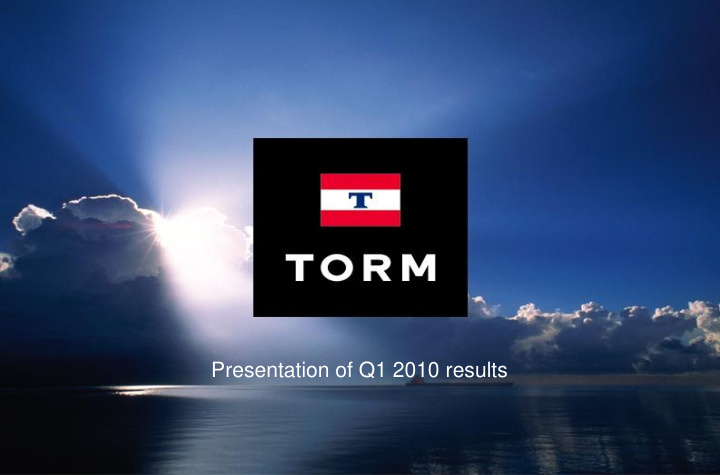



Presentation of Q1 2010 results 1
Highlights • Profit before tax of USD 3m in Q1 2010 under continued difficult market conditions • Compared to USD 39m in same period last year Results • The result was in line with expectations and the full-year forecast for 2010 • The result include USD 18m profit from sale of two bulk carriers announced in 2009 • Despite macroeconomic recovery mode, product tanker rates have remained at a low level • LR segment positively impacted by continued naphtha demand in the Far East, partly offset by Tanker Division discharging of floating storage • MR segment supported by the hard winter - increased demand for heating oil and better rates for ice-class vessels • Continued high influx in 2010, though with considerable delay in new deliveries • The Panamax Bulk rates have remained strong during Q1 2010 • Supported by continued strong iron ore and coal imports into China Bulk Division • Significant influx of new tonnage • Vessel values have bottomed out and have been increasing during Q1 and into Q2 Fleet value • On track to deliver USD 50m savings in 2010 compared to 2008. Greater Efficiency Power • 15% reduction in OPEX/day and 20% reduction in administration costs (2010 compared to 2008) • Cash and unused credit facilities available of app. USD 700 m Financial position • Remaining capex related to newbuilding programme of USD 435 m • Maintained guidance, a loss before tax of USD 15 to 60m, however towards the lower end of the 2010 guidance range • Covered 26% at USD/day 18,821 in Tanker Division and 81% at USD/day 18,972 in Bulk Division Coverage of earning days 2
Continued difficult conditions on the product tanker market Freight rates (MR and LRs) Rates have remained low despite economic recovery USDt MR spot rates and 1 year T/C rates Positive 30 • Increased petrochemical production in the Far East led to higher naphtha demand 20 • Cold winter increased the demand for heating fuel (US demand up in Jan by 65% y-o-y) • Demand for TORM’s ice -class vessels pushed the 10 rates above the general market levels • Swap of LR2s into dirty supported the tonnage 0 balance in this segment Jan/09 Apr/09 Jul/09 Oct/09 Jan/10 Apr/10 MR spot rates (TC2) Negative MR 1 year T/C rates • High influx of new tonnage, though with significant TC2 spot avg 2005-2009 delay USDt LR1 and LR2 spot rates and 1 year T/C rates • Low US demand for gasoline 40 • Reduced floating storage which has freed tonnage 30 Into Q2, the rates have remained low: 20 • Refinery and petrochemical industry maintenance in Asia 10 • High gasoline inventories in the USA • Continued influx of newbuildings taking cargo out 0 of Asia Jan-09 Apr-09 Jul-09 Oct-09 Jan-10 LR1 spot rates (TC5) LR1 1 year T/C rates LR2 spot rates (TC1) LR2 1 year T/C rates LR2 vessel size (Long Range): Aframax tanker 85-120,000 dwt LR1 (TC5) spot avg. 2005-2009 LR2 (TC1) Spot avg 2005-2009 LR1 vessel size (Long Range): Panamax tanker 60-85,000 dwt 3 MR vessel size (Medium Range):Handymax tanker 40-60,000 dwt *Source: Clarksons SR vessel size (Short Range): Handysize tanker – 30-40,000 dwt
Dry bulk market has remained at a relatively strong level in Q1 Freight rates development USDt Panamax spot rates and 1 year T/C rates 100 Panamax rates have remained strong in Q1 2010 90 80 70 Rates supported by 60 • Chinese coal and iron ore imports and 50 • 40 High congestion 30 20 TORM relatively unaffected by rate volatility 10 • Due to high coverage of earning days 0 Jan-08 Jul-08 Jan-09 Jul-09 Jan-10 At the end of March 2010, TORM has covered 81% Panamax dry bulk spot rates Panamax dry bulk 1 year T/C rates of the remaining earning days in 2010 4 *Source: Clarksons
Safe Harbour Statement Matters discussed in this presentation may constitute forward-looking statements. Such statements reflect TORM's current expectations and are subject to certain risks and uncertainties that could negatively impact TORM's business. To understand these risks and uncertainties, please read TORM's announcements and filings with The US Securities and Exchange Commission. The presentation may include statements and illustrations concerning risks, plans, objectives, goals, strategies, future events or performance, and underlying assumptions and other statements, which are other than statements of historical facts. The forward-looking statements in this presentation are based upon various assumptions, many of which are based, in turn, upon further assumptions, including without limitation, TORM's examination of historical operating trends, data contained in our records and other data available from third parties. As many of these factors are subject to significant uncertainties and contingencies which are difficult or impossible to predict and are beyond our control, TORM makes no warranties or representations about accuracy, sequence, timeliness or completeness of the content of this presentation. 5
Q&A 6
Recommend
More recommend